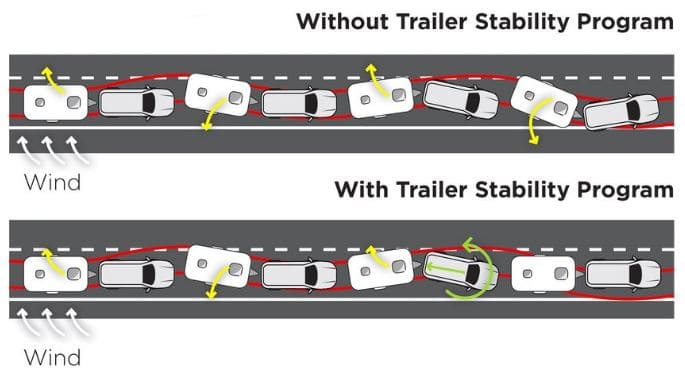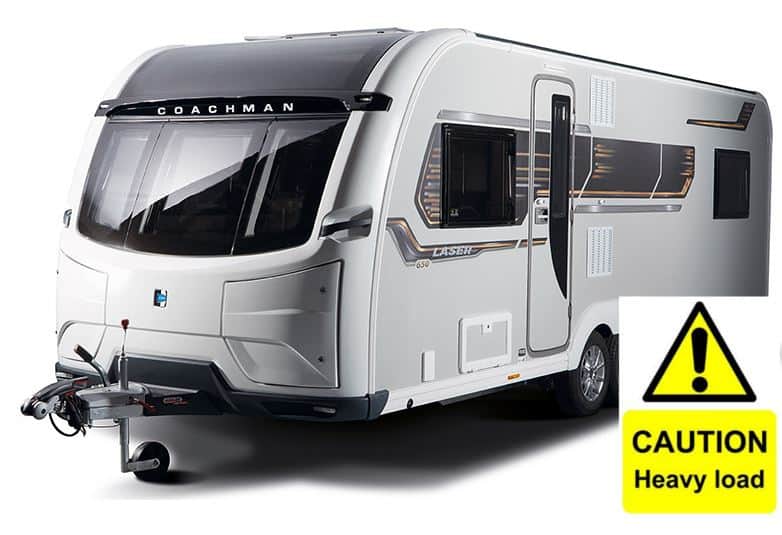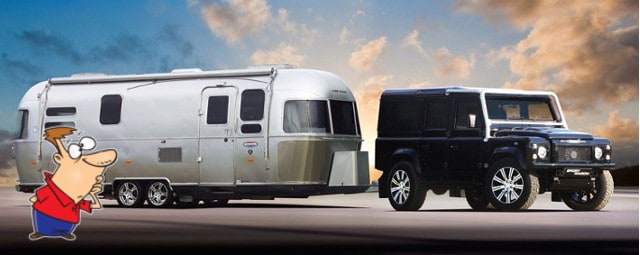
Sometimes when our guests arrive at Horton Common I get told hold how their trip went. In most cases, it will simply be a conversation about the amount of traffic on the roads. However, in other cases, I’ve had guests talk about their caravan snaking on the motorway. Snaking is pretty much as it sounds. At a certain speed, the caravan will start moving left to right. If conditions don’t change to bring the tow car and caravan under control, that side-to-side movement may get even worse where the caravan jack-knives.

Jack-knifing is where the caravan gets perpendicular to the tow car, which can potentially result in the car and caravan overturning.
With this post, I want to discuss what you can do to avoid a potential snaking/jack-knifing situation with your caravan.
I’ve written quite a few posts now around caravan safety, and they are mostly all applicable to avoiding a caravan snaking while towing.
Therefore, throughout the content below, I will be linking to those various posts, which will provide more detail.
To avoid caravan snaking/jack-knifing, there are lots of variables at play. For instance, your caravan tyres need to be in good condition and at the right pressure.
Your caravan needs to be under its maxium permitted laden weight and loaded correctly.
However, your tow car also needs to be of sufficient weight to better control the caravan during unstable towing conditions. All these factors and more will be discussed below.
Disclaimer: Hey! By the way… any links on this page that lead to products on Amazon or Caravan Guard are affiliate links, and I earn a commission if you make a purchase, with no additional cost to you 🙂
- Dissolves waste and removes odours naturally and has delightful mild fragrance
Want To Visit Horton Common? – Book Here
Table of Contents
Introduction To Caravan Snaking & Jack-Knifing
Caravan snaking is an unstable towing situation which may ultimately lead to jack-knifing. I’ve got a general post on how to tow a caravan which is also worth checking out.
The main objective of this post is to help avoid caravan snaking in the first place. However, you also need to be prepared and know what to do if your caravan does start to snake on a fast A road or motorway.
Therefore below, I’ve included a very good video from Caravan Guard filmed with the driving school Towing Solutions.
So, in summary, Frank, in the video above, provides some important tips and hints. The only point I would personally add is to put your hazard lights on to warn other motorists of the issue.
This will hopefully indicate to other road users they should keep their distance until you have the car and caravan under control. If the caravan starts to snake, you should do the following:
- Losen your grip on the steering wheel
- Take your feet off all the pedals
- Change down a gear
- Pullover and check the car/caravan
One of the most important points is to use engine braking, not the wheel brakes, to gently slow down the car and caravan until both are under control.
As Frank states in the video, the best approach is not to accelerate out of the problem, which I have myself heard referenced before as the solution.
When a caravan is snaking, its a form of kinetic energy (movement energy).
To get the car and caravan under control again, that kinetic energy needs to dissipate. If you accelerate or brake, both of those forces are additional sources of kinetic energy which can actually make the situation worse.
You will have to adjust the points above on how to stop a caravan snaking for your own specific circumstances.
For instance, if you are driving an automatic, depending on the car, you may not be able to manually select a lower gear to increase engine braking resistance.
Also depending on what type of road you are on a safe place to pull over and check the tow car and caravan will also obviously vary.
How To Avoid Caravan Snaking
The above video from Caravan Guard/Towing Solutions has stated what you should do if your caravan starts snaking on the road.
However, my main aim of this post is to help you avoid that situation happing in the first place.
Therefore, please read the various sub-topics below and click the links to my additional post to read more about the specific topics.
Caravan Weights & Weight Distribution
So the first area to focus on to avoid snaking is to make sure you do not overload your caravan beyond its MTPLM (Maximum Technically Permissible Laden Mass).
You also need to make sure that the caravan is loaded correctly. For instance, the heaviest items should be over the axle of the caravan.
Obviously, depending on whether you have a single or twin-axle caravan the available floor space directly over the axle will vary. I would encourage you to read my posts below on these particular topics:
- How much does a caravan weigh?
- How to check the noseweight of your caravan
- Caravan user payloads – Is your caravan overweight?
- How to load and pack your caravan safely
- How to weigh a caravan or motorhome

Caravan payloads need particular attention. From speaking to our guests on the subject, some are not aware that items such as motor movers need to be discounted from the payload allowance.
Hence, sometimes after looking at the payload allowance on their caravan’s weight plate, they believe they have more payload allowance than they actually do.
That’s why its important to check the actual fully laden weight of your caravan and not to just add up the weight of your individual belongings.

A caravan weigh scale such as this can be a handy tool. However, I would still encourage you to get the final check at a public weighbridge: Image – Amazon.co.uk
Caravan Stability Systems & Devices
As Frank states in the video above, caravan stability systems and devices are great and its better to have them than not.
However, they should never be seen as an excuse to overload a caravan or ignore the proper weight distribution of your belongings in the caravan.
Caravan stability devices are aids. In other words, they’re the backup plan should the caravan still suffer towing instability issues. However, they can only do so much.

A typical example of a caravan stabiliser hitch. This is a Winterhoff hitch, AL-KO hitches look a little different with either a red of black handle: Image – Amazon.co.uk
With the above example of a caravan stabiliser hitch fitted to most caravans in the last two decades, they have friction pads.
These friction pads grip the sides of the tow ball to resist caravan sway/snaking. However, when you think about it, they can only have a very small contact area against the towball.
Hence, they can only assist with helping to reduce caravan sway/snaking. They cannot guarantee it won’t happen.
Furthermore, if the caravan is not annually serviced, the friction pads will not be checked and changed accordingly.
A caravan stabiliser hitch with worn friction pads will provide significantly less assistance to reduce caravan sway/snaking.

A typical example of a blade-type caravan stabilizer which was used before stabiliser hitches became common practice: Image – Amazon.co.uk
As I reference in my post on caravan stabilisers, there are electronic stability systems such as AL-KO ATC, which can help to reduce incidences of caravan sway/snaking.
The ATC system applies the caravan brakes in a controlled manner.
However, the electronics in these systems can fail. Hence, while its good to have them, you shouldn’t rely on them.
The first and most important element of stopping caravan sway/snaking is to not overload the caravan and focus on proper weight distribution.
Caravan Tyre Safety Is Very Important To Avoid Snaking
You need to make sure your caravan tyres are in good/safe condition before you set off on every trip.
That includes checking the tread depth, sidewall condition and checking they are at the right pressure. I’ve written several posts on these topics now, which I will link to below.
If a caravan tyre is in a really poor state, it could lead to a blowout. If you are travelling on a fast A road when this happens or a motorway, a tyre blowout can have serious consequences.
Even if your caravan is not overweight and loaded correctly, if a tyre blows out, you will enter a snaking situation which could lead to jack-knifing.
- How long do caravan tyres last?
- Caravan tyre pressure guide
- Best caravan tyre pressure gauges
- Caravan tyre pressure monitors
- How to change a flat caravan tyre
I do very much encourage any caravan owner to consider some form of tyre monitoring solution.
Having an active readout on your car’s dashboard, which can potentially give you a heads-up on a tyre issue before a fault occurs, is obviously very valuable.
However, even with a tyre pressure monitoring setup, before you set off, I would encourage you to manually check your caravan tyre pressures.
A tyre monitoring sensor may be faulty and not give an accurate reading.
Hence, in the same way you have to test smoke detectors, you also want to check your tyre pressure monitor is actually working properly.

While I do encourage the use of caravan tyre pressure monitors I also encourage manually checking the pressure in the tyres before you set off: Image – Amazon.co.uk
Does Your Tow Car Properly Match Your Caravan?
To reduce the odds of your caravan snaking, which potentially leads to a jack-knifing situation, you need to make sure the weight of your tow car and its towing capabilities are in line with your caravan.
Now the 85% ‘rule’ that often gets referred to in caravan magazines/forums etc, is not bad advice.
But its also generally acknowledged that experienced caravaners can safely tow a 1:1 weight relationship of tow car and caravan.
However, if your caravan is heavier than your car, you are more likely to end up with the caravan snaking at some point.
Likewise, if you have a very small/lightweight caravan, such as a teardrop, you are far less likely to experience towing instability.

Now, many modern cars have various electronic stability control systems. In some cases, they are designed specifically for safer towing.
However, again as referenced above, these systems should not be blindly relied upon to get you out of trouble.
You still need to check the weight of your caravan. You still need to pay close attention to weight distribution.
Furthermore, you still need to pay close attention to the condition and pressure of your car and caravan tyres. Below are links to a couple of posts I’ve written on tow cars, which you may also wish to read.
- Best cars for towing a caravan
- Best tyres for tow cars
- 2WD vs 4WD for towing a caravan
- Electric tow cars
Conclusions On How To Avoid Caravan Snaking & Jack-Knifing
What I hope the above information has made clear is that there is not just one thing which you need to focus on to reduce the chances of your caravan snaking on the road.
A wide range of factors need to be addressed to stop a caravan from snaking in the first place.
Furthermore, you need to make sure your tow car and its towing capabilities are properly matched to your caravan.
Finally, please watch the video at the top of this post from Caravan Guard/Towing Solutions on what to do if you do end up in a snaking situation.
That advice could very well be the difference between a scary experience and a potentially fatal event in a jack-knifing incident. I have another post on caravan safety and security advice you may wish to read.
Thanks for reading. I hope you found the information above useful.
I also hope, at some point in the near future, you consider coming to visit us here at Horton Common caravan site to experience our fully serviced pitches and amazing views. 🙂
Want To Visit Horton Common? – Book Here


